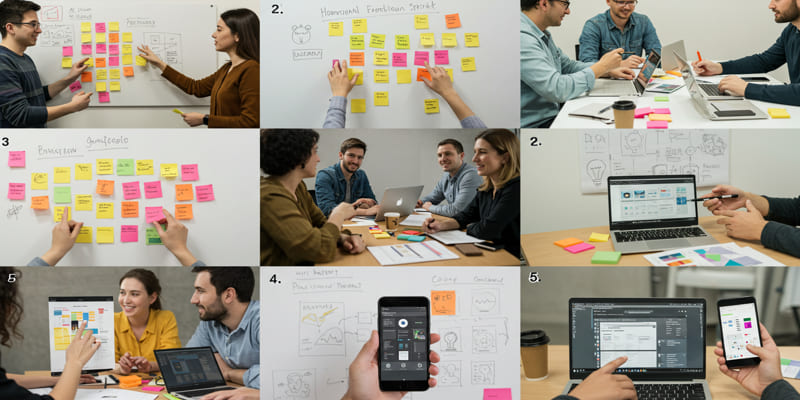The technological world advances quickly which makes artificial intelligence a key tool for developing new ideas. Your journey through AI design requires you to turn AI ideas into sellable products while facing this problem. The AI Design Sprints system helps you turn your ideas into commercial AI products. Using this approach connects design thinking strengths with AI technology to help you reach the market faster while keeping ahead of your industry rivals.
How AI Design Sprints Help Deliver Product Value

Traditional design sprint practices power up when combined with artificial intelligence to form an effective design sprint method. The system helps teams generate AI ideas faster by testing and validating them through working prototypes in a short space.
Core Principles
The core elements of the AI Design Sprint methodology contain two key components.
- Rapid iteration
- Cross-functional collaboration
- Data-driven decision making
- User-centric design
The principles of fast idea development let teams produce tangible prototypes while artificial intelligence helps them find better solutions.
Key Phases
An AI Design Sprint follows these main steps for its process.
- Your team must specify the current issue and define what you want to achieve in the project.
- Ideation: Generating a wide range of potential AI-powered solutions
- The team uses artificial intelligence tools to develop basic representations of product ideas.
We use user input to assess AI data findings and product testing results.
We improve our work according to feedback from users while taking AI suggestions for optimization.
The use of AI technology to Improves how Design Sprints Complete Tasks
Automating Rapid Prototyping
AI design tools speed up the prototype development stage of design sprints. Advanced systems can now create interactive prototypes by themselves which allows teams to design and test multiple possibilities at a speed once only achievable through manual effort. The use of AI algorithms helps designers produce design suggestions using fundamental techniques combined with user preferences and market standards to show them prototype options that match user needs effectively.
Enhancing User Testing and Feedback Analysis
Artificial intelligence now helps design sprint teams better collect and understand user reactions. AI technology scans user feedback data to recognize customer problems and optimization opportunities. Designers receive clear improvement directions from this system to enhance their prototype results. AI user testing tools help detect product use problems by monitoring user behavior and performance which shortens testing cycles and lets designers improve their prototypes quickly.
Streamlining Collaboration and Decision-Making
AI helps teams simplify their design sprint decision process and collaboration. Teams use artificial intelligence to do their work faster while making better decisions about data and concepts. Better team connections result in faster decisions and speed up all design sprint phases.
Why Organizations adopt AI Design Sprints

Accelerating Innovation and Time-to-Market
AI Design Sprints provide a strong method to speed up development of new products by taking ideas from inception to market launch quickly. Organizations using design thinking with sprint methodology reach their market faster by 30% than traditional development methods. These scrum routines help teams spot AI prospects fast while creating working models then getting user feedback well before the set deadline.
Enhancing Collaboration and Alignment
Through AI Design Sprints teams gain better abilities to work with each other while understanding their projects better. When team members from different departments attend sprints they use their skills to form a strong AI strategy for the company. Team members can concentrate their efforts more effectively since they work on the tasks that show the greatest potential.
Design Sprints Strategy
With AI Design Sprints users become the essential focus during the creation of AI systems. Teams create better products through quick designs and assessments so they can enhance their work before building everything. Placing users at the core of projects improves results and lowers the chance of problems in AI development. Organizations detect problems right away which allows them to spend less time and money on the project.
Step-by-Step Guide to Executing Successful AI Design Sprints
Preparation and Team Assembly
Good results rely on good preparation before starting an AI Design Sprint. Form a small team of staff that blends skills like product management and AI with visual design and engineering. Determine the project goal and collect all data from specific trouble spots. AI tool Product Design Sprint Assistant from Thoughtbot provides teams with both process automation and stay on track features.
The Sprint Process
In an AI Design Sprint teams go through a defined workflow which normally lasts from two to five days. The process involves:
- Look at user pathways to find where users have trouble
- Set design rules and measure significant values in order to define requirements.
- The teambrainstorms new ideas during this stage.
- Decide: Select the best concept through anonymous voting
- Prototype: Create a testable version of the AI solution
- Accept feedback by conducting user evaluations and testing product useability.
Leveraging AI Tools
Use artificial intelligence tools across the sprint cycle to save time when researching options and developing early product drafts. Apply customized ChatGPT models to develop insights alongside DALL-E for wireframe designs and CodePen for interactive prototypes. Develop AI solutions by refining your prompts and designing high-quality data. Be sure to evaluate AI ethical factors and connection requirements during the complete process.
- Organizations experience typical difficulties in AI Design Sprint deployment so teams need solutions.
- Organizations face special challenges when they begin to use AI Design Sprints. Teams that face AI Design Sprint challenges effectively will increase their ability to transform ideas into working AI market products.
How to Select the Right AI application for your Business
Identifying proper business applications for AI poses the main difficulty during an AI Design Sprint process. Leaders should deeply study their company operations to find tasks that hail from AI yet always improve productivity. Integrating AI experts before the sprint start-up phase determines what problem to address and defines project boundaries.
Aligning Cross-functional Teams
Designers, data analysts and engineers with different skills need to work together for successful AI projects. When we want successful idea generation and creativity from our cross-functional staff we need to bring them together. The team should engage in joint work at all stages while using AI Cards to represent advanced artificial intelligence structures.
Prototyping AI-powered Interactions
Building AI experience prototypes needs special attention to make them easy to understand. Teams must test simple prototype models to check how users interact with AI technology. The AI Design Sprint now offers 50+ precise tools to explain advanced AI systems for team members who are not technical experts.
Conclusion
The AI design sprint process helps take new ideas from development to market-ready result. You can speed up your AI project delivery while building audience-focused solutions through fast development methods together with team collaboration and user input techniques.











